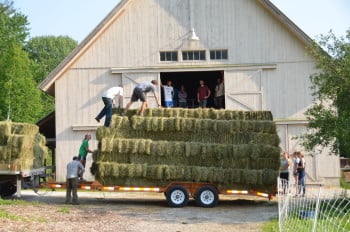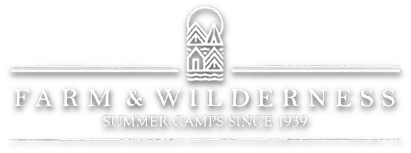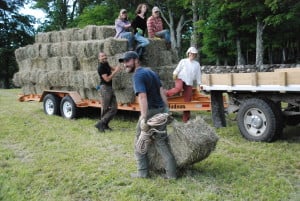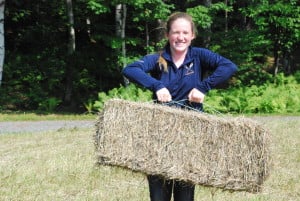October 2015
As the weather turns cooler and we start unpacking our winter clothes in anticipation of frosty mornings here at the Farm, it’s a good time to reflect on the warmer days earlier this past summer. One project we started in June is now wrapping up: filling the barn with organic hay to feed the animals through the winter.
Here at Farm & Wilderness, we graze our animals on fresh pasture for as much of the year as possible, usually from about mid-May through October. The rest of the year there is either snow on the ground, or it’s too cold for the pasture grasses to grow, and so the animals must eat hay. Hay preserves the nutritious leaves and stems of the grasses and legumes, such as clover, that are found in a pasture. This fodder shouldn’t be confused with straw, which is the dried stalks left over after a grain crop like wheat or oats is harvested. By setting aside a portion of our pasture land for hay, it allows us to harvest the grass during the summer and save it for the winter months. We also maintain certified organic hayfields at two other locations near the camp property, to augment the hay we need to make it through the entire winter.
 Putting up hay is a very weather-dependent process. Rain hay that gets wet is often ruined because the water leaches nutrients from the cut grass. Similarly, hay will mold if it isn’t sufficiently dry when it gets baled. So we must keep an eye on the forecast to determine when there is a window of at least three or four consecutive sunny days to cut a hayfield. Once the grass is cut using a special mower that preserves the integrity of the stems and leaves, it then gets tedded (turned, or “fluffed”) several times over the next couple days, to expose all the surfaces to the sun, which helps the grass dry and evaporate the morning dew. When the hay is dry enough, it is raked into windrows and a large noisy piece of equipment called—appropriately enough—a baler collects the hay, compresses it into bales, and ties them up with twine. There are many different styles of baler, but the one we use at F&W produces square bales weighing about 40-50 pounds each.
Putting up hay is a very weather-dependent process. Rain hay that gets wet is often ruined because the water leaches nutrients from the cut grass. Similarly, hay will mold if it isn’t sufficiently dry when it gets baled. So we must keep an eye on the forecast to determine when there is a window of at least three or four consecutive sunny days to cut a hayfield. Once the grass is cut using a special mower that preserves the integrity of the stems and leaves, it then gets tedded (turned, or “fluffed”) several times over the next couple days, to expose all the surfaces to the sun, which helps the grass dry and evaporate the morning dew. When the hay is dry enough, it is raked into windrows and a large noisy piece of equipment called—appropriately enough—a baler collects the hay, compresses it into bales, and ties them up with twine. There are many different styles of baler, but the one we use at F&W produces square bales weighing about 40-50 pounds each.
Up to this point, the farmer has been in charge of running the tractor and all of the haying equipment. But once the bales are ready, it’s time for everyone else to join in the fun. During the summer, Tamarack Farm campers, summer staff, and all the farm crew help to load the hay bales on trucks and trailers to take them to the barn. Then the bales go up into the loft to be stacked again for storage. Depending on the field, there can be as many as 500 bales in one day! It’s no small task to move that many bales, and by the end everyone is tired and sweaty and ready for a dip in the lake to cool off.
The summers are short — but productive — as nature takes advantage of the short growing season. With the addition of organic fertilizers like chicken manure or the composted waste from our camp kitchens, our hayfields can support two cuttings each summer. We end up moving equipment from one field to the next and back again, but from the first part of June until the end of September this year we were able to put up more than 1,800 bales of hay, enough that we shouldn’t have to buy any additional hay this winter.
So as the leaves change color, the animals and all of us at the farm can be thankful for summer’s bounty heading into the winter, even as we anticipate the greener days again next spring.
— Adam Gelroth, Assistant Farm Manager






